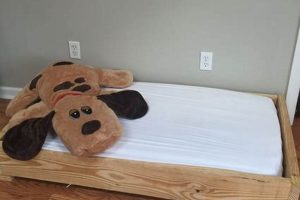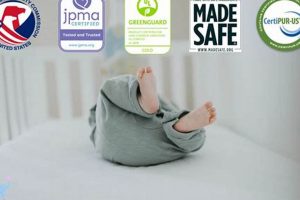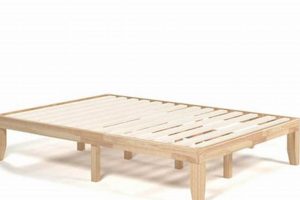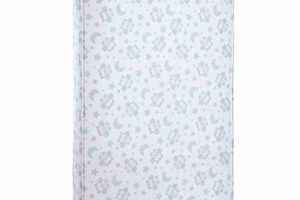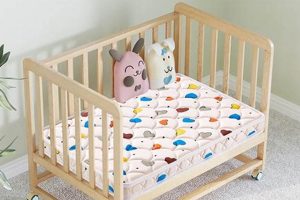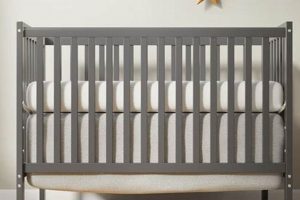A protective layer designed to shield a baby’s sleeping surface from liquids. Typically constructed from absorbent materials with a waterproof backing, these items fit securely over a standard crib mattress, preventing moisture damage from spills, accidents, or diaper leaks. As an example, consider a quilted fabric layer bonded to a polyurethane film, creating a barrier while maintaining a comfortable surface for the infant.
The use of such protection offers multiple advantages. It prolongs the lifespan of the crib mattress by preventing staining and deterioration caused by moisture. This is particularly significant considering the cost of crib mattresses. Furthermore, it contributes to a more hygienic sleep environment, reducing the risk of bacterial growth and unpleasant odors. Historically, parents have used makeshift solutions, such as rubber sheeting, which lacked breathability and comfort, highlighting the evolution and improved design of modern products.
The subsequent sections will delve into the selection criteria, material composition, care instructions, and safety considerations associated with choosing an appropriate protective layer for an infant’s sleeping area.
Selection Guidance for Crib Mattress Protection
The following recommendations are intended to aid in the selection of an appropriate layer to safeguard a crib mattress, ensuring both hygiene and longevity of the sleeping surface.
Tip 1: Prioritize Material Safety. Scrutinize the material composition for certifications such as Oeko-Tex Standard 100, indicating the absence of harmful substances like phthalates, lead, and formaldehyde. Select products explicitly labeled as non-toxic.
Tip 2: Assess Waterproofing Effectiveness. Evaluate the backing material for its ability to completely block liquid penetration. Polyurethane film is a common and effective option; however, ensure it is securely bonded to the top layer to prevent separation.
Tip 3: Consider Breathability. While waterproofing is crucial, breathability is equally important to prevent overheating and promote airflow. Look for products with a breathable top layer, such as cotton or bamboo.
Tip 4: Evaluate Fit and Security. The protective layer should fit snugly on the crib mattress, akin to a fitted sheet, with secure elasticized edges. A loose fit can pose a safety hazard.
Tip 5: Review Washability and Durability. Opt for machine-washable and dryer-safe options for ease of cleaning. Check customer reviews regarding the product’s durability after repeated washings.
Tip 6: Examine Noise Level. Some waterproof materials can be noisy when the baby moves. Consider a quilted or padded option to minimize rustling sounds that may disrupt sleep.
Tip 7: Compare Warranty and Return Policies. Check the manufacturer’s warranty and return policy. This can provide recourse in case of manufacturing defects or unsatisfactory performance.
Adhering to these guidelines will help ensure that the chosen protection effectively safeguards the crib mattress while providing a safe and comfortable sleep environment for the infant.
The concluding section will address maintenance and cleaning protocols for the chosen protective layer, ensuring continued hygiene and functionality.
1. Material Composition
The material composition of a waterproof crib mattress protector directly influences its safety, effectiveness, and comfort. The selection of appropriate materials is critical in mitigating potential health risks and ensuring long-term performance.
- Top Layer Materials: Absorbency and Comfort
The top layer, in direct contact with the infant, typically consists of absorbent materials such as cotton, bamboo, or polyester blends. Cotton offers breathability and softness but may require blending with other materials for enhanced durability. Bamboo provides inherent antimicrobial properties and increased moisture-wicking capabilities. Polyester blends offer cost-effectiveness and enhanced resistance to wear and tear, though breathability may be compromised. The choice impacts the baby’s comfort and the overall absorbency of the layer.
- Waterproof Barrier: Impermeability and Safety
The waterproof layer typically comprises polyurethane (PU) film or thermoplastic polyurethane (TPU). PU offers effective waterproofing but may contain chemicals of concern. TPU is considered a safer alternative, often free of PVC, phthalates, and other harmful substances. The integrity of this layer is paramount; any breaches compromise the protective function. Its composition dictates the overall safety profile and the protector’s ability to prevent liquid penetration.
- Binding and Stitching Materials: Durability and Security
Binding and stitching materials secure the layers together, influencing the protector’s structural integrity. Commonly used are polyester or nylon threads and edge bindings. These materials must be durable to withstand repeated washing and use. Flimsy stitching can lead to delamination, reducing the product’s lifespan and potentially creating choking hazards. The quality of these components directly impacts the protector’s durability and safety.
- Certifications: Ensuring Material Safety
Certifications such as Oeko-Tex Standard 100 provide assurance that the materials used are free from harmful levels of chemicals and substances. GOTS (Global Organic Textile Standard) certification indicates that the cotton or other organic fibers used are grown and processed according to strict environmental and social criteria. The presence of these certifications provides a level of confidence in the product’s overall safety and environmental impact.
Ultimately, the material composition of a waterproof crib mattress protector must prioritize safety, functionality, and durability. Careful consideration of each component, from the top layer to the binding materials, and validation through recognized certifications are crucial steps in ensuring a healthy and effective sleep environment for infants.
2. Waterproof Barrier
The effectiveness of a waterproof crib mattress protector is fundamentally determined by the integrity of its waterproof barrier. This barrier functions as the primary defense against liquid penetration, safeguarding the mattress from contamination and potential damage. Its properties directly influence the hygiene and longevity of the crib mattress.
- Material Composition and Impermeability
The waterproof barrier typically consists of materials like polyurethane (PU) or thermoplastic polyurethane (TPU) films. These films are engineered to be impermeable to liquids, preventing fluids such as urine, spills, or diaper leaks from soaking into the mattress. The selection of material dictates the level of impermeability; TPU is often preferred for its non-toxic attributes compared to some PU alternatives. For example, a barrier constructed with a high-grade TPU film will provide superior liquid resistance and chemical safety, preventing mold growth and odors within the mattress core.
- Lamination and Bonding Techniques
The process by which the waterproof film is bonded to the absorbent top layer is critical for maintaining the barrier’s integrity. Lamination techniques, such as heat bonding or adhesive bonding, must create a robust and durable connection. Poor lamination can lead to delamination, where the waterproof film separates from the top layer, compromising its protective function. An example is a protector using heat lamination, which ensures a seamless bond resistant to separation, even after repeated washing and usage.
- Breathability Considerations
While impermeability is paramount, the waterproof barrier should also allow for some level of breathability. Excessive impermeability can trap heat and moisture, creating an uncomfortable sleeping environment for the infant. Micro-porous films or breathable laminates are designed to allow air circulation while preventing liquid penetration. For instance, a breathable TPU film incorporates microscopic pores that permit air passage but block liquid molecules, ensuring both protection and comfort.
- Durability and Resistance to Wear
The waterproof barrier must withstand the rigors of frequent use and laundering. Factors such as abrasion, temperature changes, and chemical exposure from detergents can degrade the film over time. Reinforced films or those treated with protective coatings can enhance their durability. For example, a protector featuring a reinforced TPU film exhibits increased resistance to tearing and degradation, ensuring consistent performance throughout its lifespan.
The characteristics of the waterproof barrier are central to the performance of a waterproof crib mattress protector. A well-designed barrier, utilizing safe materials, robust lamination techniques, and incorporating breathability considerations, ensures effective protection while maintaining a hygienic and comfortable sleep environment for the infant. These factors collectively contribute to the overall value and longevity of the product.
3. Breathability
Breathability is a critical attribute of a protective layer designed for crib mattresses. While the primary function is to prevent liquid penetration, the capacity to allow air circulation significantly impacts infant comfort and safety. A balance between waterproofing and airflow is essential for optimal performance.
- Thermoregulation
Infants have limited capacity to regulate their body temperature, making them susceptible to overheating. A breathable mattress protector facilitates the dissipation of heat, preventing the build-up of excess warmth. Non-breathable materials trap heat, increasing the risk of discomfort and potential health concerns. A breathable protector allows for a more stable and comfortable sleep environment.
- Moisture Management
Breathable materials permit the evaporation of moisture, such as sweat, reducing the likelihood of skin irritation and the growth of bacteria. This is particularly important during warmer months or for infants prone to sweating. Non-breathable protectors trap moisture, creating a damp environment conducive to microbial proliferation and discomfort. Breathability promotes a drier, more hygienic sleep surface.
- Material Selection
The breathability of a protective layer is directly influenced by the choice of materials. Natural fibers like cotton and bamboo offer inherent breathability, while synthetic materials may require specialized construction techniques to enhance airflow. Micro-porous films and breathable laminates allow air to permeate the barrier while maintaining waterproof properties. The selection of materials directly impacts the protector’s ability to balance impermeability and breathability.
- Construction Techniques
The manner in which the protective layers are constructed influences overall breathability. Quilted designs, for example, create air pockets that promote circulation. Loosely woven fabrics offer greater airflow compared to tightly woven alternatives. Perforations or venting incorporated into the design can further enhance breathability. These construction techniques optimize the balance between protection and ventilation.
The interplay between breathability and impermeability defines the efficacy of a waterproof crib mattress protector. A protector that effectively balances these properties contributes to a safer, more comfortable, and hygienic sleep environment for infants, mitigating the risks associated with overheating and moisture accumulation.
4. Secure Fit
The concept of “secure fit” is integral to the functionality and safety of a waterproof crib mattress pad. A properly fitted pad ensures comprehensive protection against liquid spills and accidents, preventing moisture from reaching the mattress itself. Conversely, a loose or ill-fitting pad creates gaps and openings, negating the waterproof barrier and potentially exposing the mattress to contaminants. The cause-and-effect relationship is direct: an unsecured pad leads to compromised protection, while a securely fitted pad effectively shields the mattress. For example, a pad that slips off the corners of the mattress leaves those areas vulnerable to spills, leading to potential staining, odor, and bacterial growth within the mattress core.
The importance of a secure fit extends beyond mere functionality; it is also a crucial safety consideration. A loose pad can bunch up or create folds, posing a suffocation hazard to infants. Further, if the pad shifts significantly, it could expose the bare mattress, which may not meet the same safety standards regarding flame retardancy and chemical content. Real-world examples include incidents where infants became entangled in loose bedding, highlighting the potential dangers of an improperly fitted mattress pad. The practical significance of this understanding lies in the need for parents and caregivers to meticulously select pads that precisely match the dimensions of their crib mattresses and feature robust elasticized edges to maintain a snug and secure fit.
In summary, a secure fit is not merely a desirable feature of a waterproof crib mattress pad but a fundamental requirement for both its protective function and the overall safety of the infant. Challenges in achieving a secure fit often arise from variations in crib mattress sizes and the gradual stretching of elastic over time. Regular inspection of the pad’s fit and prompt replacement when it becomes loose or damaged are essential practices. Ensuring a secure fit is paramount for optimizing the benefits and minimizing the risks associated with using a waterproof crib mattress pad.
5. Washability
Washability constitutes a critical performance parameter for waterproof crib mattress pads. Given the intended purpose of these padsprotecting against spills, accidents, and other forms of contaminationfrequent cleaning is essential for maintaining a hygienic sleep environment.
- Material Durability Post-Laundering
The ability of the materials used in a waterproof crib mattress pad to withstand repeated washing cycles significantly impacts its long-term utility. Materials must resist shrinkage, fading, and degradation of the waterproof membrane. For instance, a pad constructed with low-quality polyurethane may exhibit cracking or delamination after only a few washes, compromising its protective function. Conversely, pads employing durable materials like thermoplastic polyurethane (TPU) are engineered to maintain their integrity even after numerous laundering cycles. Regular washing should not diminish the pad’s protective capacity or structural integrity.
- Ease of Cleaning and Drying
Practicality dictates that waterproof crib mattress pads should be easily cleaned and dried. Cumbersome cleaning protocols diminish the likelihood of frequent washing, potentially leading to the accumulation of allergens and bacteria. Machine washability and dryer-safe properties streamline the cleaning process. However, specific care instructions, such as low-temperature drying or avoiding harsh chemicals, may be necessary to preserve the pad’s waterproof properties. The ease with which a pad can be cleaned directly influences its usability and hygienic value.
- Stain Resistance and Removal
The propensity of a waterproof crib mattress pad to resist staining and facilitate stain removal is an important consideration. Some materials inherently resist staining more effectively than others. Furthermore, the design of the padsuch as a dark-colored surface or a stain-resistant coatingcan influence its aesthetic appeal after repeated use. The ability to easily remove stains not only maintains the pad’s appearance but also contributes to a more hygienic sleep environment.
- Impact of Detergents and Cleaning Agents
The compatibility of the pad’s materials with common detergents and cleaning agents is relevant to its long-term performance. Harsh chemicals can degrade the waterproof membrane or damage the fabric fibers, reducing the pad’s lifespan. Manufacturers often recommend specific cleaning products or practices to avoid such damage. Adhering to these recommendations ensures that washing does not compromise the pad’s functionality or safety.
In summary, the washability of a waterproof crib mattress pad encompasses several interrelated factors, all of which contribute to its overall effectiveness and longevity. A pad that is both durable enough to withstand repeated washing and easy to clean promotes a consistently hygienic and safe sleep environment for the infant.
6. Noise Reduction
A direct relationship exists between the materials used in a waterproof crib mattress pad and the level of noise generated during infant movement. Certain waterproof materials, particularly those with a plastic or vinyl composition, tend to produce rustling or crinkling sounds upon friction. These noises, while seemingly minor, can disrupt an infant’s sleep cycle and potentially hinder their ability to achieve restful sleep. The implementation of noise reduction strategies in the design and material selection of such pads directly addresses this potential disturbance. For example, a pad employing a thick, quilted top layer can effectively dampen the sounds produced by the underlying waterproof membrane, thereby minimizing noise transmission.
The incorporation of noise-reducing features in waterproof crib mattress pads offers practical benefits beyond mere comfort. Reduced noise levels can contribute to longer sleep durations, which are essential for infant development and cognitive function. Moreover, quieter sleep environments can positively impact parental rest, leading to improved caregiving capacity. Material choices also play a crucial role; opting for pads with brushed or fabric-backed waterproof layers minimizes friction and associated noise. The real-world significance of this is evident in parental testimonials citing improved sleep quality for both infant and caregiver after switching to a noise-reducing mattress pad.
Noise reduction in waterproof crib mattress pads represents a critical design consideration that directly influences infant sleep quality and overall well-being. The selection of appropriate materials, coupled with strategic construction techniques, can effectively minimize noise generation. While complete noise elimination may not be achievable, significant reductions can be realized through careful product design and manufacturing processes. The challenges lie in balancing waterproof functionality with noise reduction while maintaining material safety and affordability. Prioritizing noise reduction in this context aligns with the broader goal of fostering optimal infant sleep environments.
Frequently Asked Questions
This section addresses common inquiries regarding the use and selection of a waterproof crib mattress pad, providing factual and objective information.
Question 1: What constitutes a safe material for a waterproof crib mattress pad?
Acceptable materials should be free from phthalates, lead, BPA, and other harmful chemicals. Certifications such as Oeko-Tex Standard 100 offer assurance of material safety. Thermoplastic Polyurethane (TPU) is often preferred over Polyurethane (PU) due to its reduced chemical content.
Question 2: How often should a waterproof crib mattress pad be washed?
Routine washing should occur at least monthly, or more frequently if visibly soiled. Spills and accidents necessitate immediate laundering. Refer to the manufacturer’s instructions for specific washing recommendations.
Question 3: Can a waterproof crib mattress pad replace a fitted sheet?
A waterproof crib mattress pad is intended to be used under a fitted sheet. It provides a protective barrier, but does not offer the comfort or hygienic benefits of a fitted sheet. A fitted sheet should always be used as the top layer.
Question 4: Does a waterproof crib mattress pad impede air circulation?
While some materials may reduce breathability, quality pads utilize breathable membranes or fabrics that allow for air circulation. Look for products specifically designed to minimize heat retention and promote airflow.
Question 5: How does one ensure a proper fit for a waterproof crib mattress pad?
Measure the crib mattress dimensions and select a pad with corresponding measurements. Elasticized edges or fitted sheet designs are necessary to maintain a secure fit and prevent shifting during use.
Question 6: What is the lifespan expectancy of a waterproof crib mattress pad?
The lifespan varies based on material quality, frequency of use, and laundering practices. High-quality pads, properly maintained, can last for several years. Inspect the pad regularly for signs of wear or damage and replace as needed.
In summary, selecting a safe, well-fitting, and easily washable waterproof crib mattress pad is crucial for maintaining a hygienic and protected sleep environment for infants.
The subsequent section will provide guidance on troubleshooting common issues associated with these pads.
Waterproof Crib Mattress Pad
This article has comprehensively examined the characteristics and considerations surrounding the use of a waterproof crib mattress pad. From material composition and waterproof barrier effectiveness to breathability, secure fit, washability, and noise reduction, each aspect contributes to the overall performance and suitability of the product. The understanding of these elements is paramount in selecting a pad that effectively safeguards the crib mattress while promoting a healthy sleep environment.
The proper selection and maintenance of a waterproof crib mattress pad directly impacts infant health and safety. Diligence in choosing a product that meets established safety standards and adherence to recommended care practices is essential. The long-term consequences of neglecting these factors can range from compromised mattress integrity to potential health risks for the infant. Continued vigilance and informed decision-making remain crucial in ensuring the well-being of the child.


